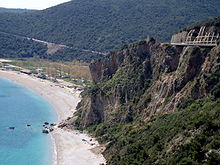Adriatic Highway
This article needs additional citations for verification. (July 2012) |





The Adriatic Highway (
Sections
The Adriatic Highway runs along the east coast of the Adriatic Sea, passing through three countries: Croatia, Bosnia and Herzegovina and Montenegro. Most of the highway is located in Croatia.
Croatian section
The Croatian section of the Adriatic Highway is officially named the
Until recent times the highway has been the primary route connecting Adriatic coastal parts of Croatia. Since the 2000s multilane motorways have taken over most of its traffic, and yet more motorways are still being built along the coast. The motorways parallel to the road are the
The D8 section from Rijeka to Senj experiences particularly heavy traffic in particular because many motorists are unwilling to take the longer route via the A6 and A1, even though the motorway route normally requires shorter travel time. Before 2009, this problem would be further exacerbated as the A6 still had some slow
Since the parallel A1 motorway terminates at the Ploče interchange,[5] approximately 20 km (10 mi) northwest of Ploče, tourists heading south generally switch to the Adriatic Highway. Further 30 km (20 mi) after Ploče drivers also encounter a small strip of Bosnia and Herzegovina territory around town of (Neum) between Klek and Zaton Doli.[4] After that section, the highway continues to Dubrovnik close to the coastline.
Upon the completion of A7 and A1 the part of Adriatic Highway spanning from Ploče to Dubrovnik are planned to be upgraded to an expressway bypassing Neum in Bosnia and Herzegovina entirely via a series of tunnels and bridges, Pelješac Bridge being the most notable among them. The possibility of other upgrades remains open.
East of Dubrovnik the road passes by Dubrovnik Airport and reaches the border with Montenegro at Karasovići (Debeli Brijeg on the Montenegrin side).[4]
Bosnia and Herzegovina section
The highway passes through a small strip of Bosnia and Herzegovina territory at Neum and is classified as M-2 road (Bosnian: Magistralna cesta M-2). The border crossings are at Neum 1 (with Klek on the Croatian side) to the west of Neum, and Neum 2 (with Zaton Doli on the Croatian side) to the east.
Montenegrin section
Within Montenegro, the road is official classified as the
, having two lanes for its entire length.The road itself runs around the
, to span the eponymous strait, is planned to allow traffic to bypass most of the bay.The Montenegrin section, albeit as narrow as the Croatian section, still remains the only feasible route along the Adriatic coast. As yet, there are no plans for any motorways along the coast of Montenegro to replace it.
There are three major roads from the Adriatic Highway to inland Montenegro – at Budva, via M-10 to Cetinje, at Petrovac, via M-2 to Virpazar and Podgorica, and at Sutomore, via the Sozina Tunnel (M-1.1), also to Virpazar and Podgorica.
The road is the part of
Sources
- ^ Radimir Čačić (November 2006). "Adriatic-Ionian Transport Corridor on the territory of the Republic of Croatia" (PDF). Regional Economic Forum Southeast Europe. Archived from the original (PDF) on December 29, 2009. Retrieved September 8, 2010.
- ^ "Snow and gale force winds block traffic between Dalmatia and the northern Croatia". Večernji list (in Croatian). December 15, 2009.
- ^ a b "Odluka o razvrstavanju javnih cesta" [Decision on categorization of public roads]. Narodne novine (in Croatian). May 10, 2013.
- ^ a b c "Map of border crossings and customs office areas" (PDF). Customs Administration of the Republic of Croatia (in Croatian). March 6, 2008.
- ^ "Regulation on motorway markings, chainage, interchange/exit/rest area numbers and names". Narodne novine (in Croatian). April 24, 2003. Archived from the original on October 4, 2011. Retrieved August 8, 2010.
